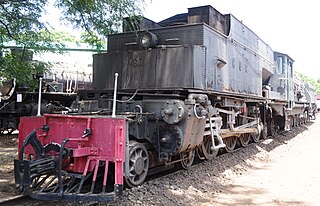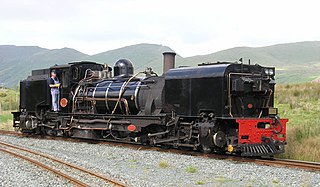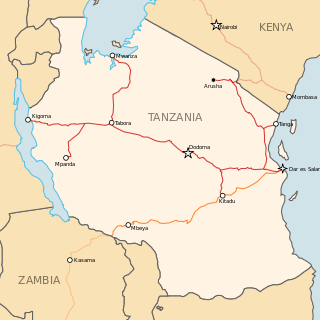
The KUR EC3 class, later known as the EAR 57 class, was a class of 1,000 mm gauge 4-8-4+4-8-4 Garratt-type articulated steam locomotives. The twelve members of the class were built by Beyer, Peacock & Co. in Manchester, England, for the Kenya-Uganda Railway (KUR). They entered service between 1939 and 1941, and were later operated by the KUR's successor, the East African Railways (EAR).

The EAR 58 class was a class of 1,000 mm gauge 4-8-4+4-8-4 Garratt-type articulated steam locomotives built by Beyer, Peacock & Co. in Manchester, England, in 1949.
The KUR EC class was a class of 1,000 mm gauge 4-8-2+2-8-4 Garratt-type articulated steam locomotives. The four members of the class, built by Beyer, Peacock & Co. in Manchester, England, were the first Garratts to be ordered and acquired by the Kenya-Uganda Railway (KUR). They entered service in 1926, and, after a relatively short but successful career with the KUR, were sold and exported to Indo-China in August 1939.
The KUR EC1 class, later known as the EAR 50 class and the EAR 51 class, was a class of 1,000 mm gauge 4-8-2+2-8-4 Garratt-type articulated steam locomotives.

The EAR 31 class was a class of oil-burning 1,000 mm gauge 2-8-4 steam locomotives. The 46 members of the class were built in 1955 by Vulcan Foundry, in Newton-le-Willows, Lancashire, England, for the East African Railways (EAR). They were a lighter, branch-line version of the EAR 30 class, and worked from various sheds throughout the EAR system.

The KUR EC4 class, later known as the EAR 54 class, was a class of 1,000 mm gauge 4-8-2+2-8-4 Garratt-type articulated steam locomotives developed under and for use in wartime conditions.
The EAR 56 class was a class of 1,000 mm gauge 4-8-2+2-8-4 Garratt-type articulated steam locomotives built by Beyer, Peacock & Co. in Gorton, Manchester, England, in 1949. The six members of the class were ordered by the Kenya-Uganda Railway (KUR) immediately after World War II, and were a slightly modified version of the KUR's existing EC5 class.

The TR DL class, later known as the EAR 23 class, was a class of 1,000 mm gauge 4-8-0 steam locomotives derived from the Nigerian Railways Emir class. The six members of the DL/23 class were built by Beyer, Peacock & Co. in Gorton, Manchester, England, for the Tanganyika Railway (TR). They entered service on the TR in 1923, and were later operated by the TR's successor, the East African Railways (EAR).
The TR MK class, later known as the EAR 25 class, was a class of 1,000 mm gauge 2-8-2 steam locomotives. The eleven members of the class were built by Vulcan Foundry, in Newton-le-Willows, Lancashire, England, for the Tanganyika Railway (TR). They entered service on the TR in 1925–1926, and were later operated by the TR's successor, the East African Railways (EAR).
The TR RV class, later known as the EAR 21 class, was a class of 1,000 mm gauge steam locomotives designed and built for the Tanganyika Railway (TR) as a 4-8-2 development of the 2-8-2 TR MK class. The eight members of the RV class were built by Vulcan Foundry, in Newton-le-Willows, Lancashire, England.

The EAR 60 class, also known as the Governor class, was a class of 1,000 mm gauge 4-8-2+2-8-4 Garratt-type articulated steam locomotives built for the East African Railways as a development of the EAR's existing 56 class.
The TR ML class, later known and expanded as the EAR 26 class, was a class of 1,000 mm gauge 2-8-2 steam locomotives designed for and ordered by the Tanganyika Railway (TR), as a development of the TR MK class.

The KUR ED1 class was a class of 1,000 mm gauge 2-6-2 T steam locomotives built for the Kenya-Uganda Railway (KUR). The 27 members of the ED1 class entered service on the KUR between 1926 and 1930. They were later operated by the TR's successor, the East African Railways (EAR), and reclassified as part of the EAR 11 class.

The KUR EC5 class was a class of 1,000 mm gauge 4-8-4+4-8-4 Garratt-type articulated steam locomotives built during the latter stages of World War II by Beyer, Peacock & Co. in Gorton, Manchester, England, for the War Department of the United Kingdom. The two members of the class entered service on the Kenya-Uganda Railway (KUR) in 1945. They were part of a batch of 20 locomotives, the rest of which were sent to either India or Burma.
The UR G class, known later as the UR / KUR GA class, and later still as the KUR EB class, was a class of 1,000 mm gauge 4-8-0 steam locomotives built by Nasmyth, Wilson and Company in Patricroft, Salford, England, for the Uganda Railway (UR). The seven members of the class entered service on the UR in 1914, and continued in service after the UR was renamed the Kenya-Uganda Railway (KUR) in 1926.
The UR GB class, known later as the UR / KUR EB1 class, and later still as part of the EAR 22 class, was a class of 1,000 mm gauge 4-8-0 steam locomotives built by North British Locomotive Company in Glasgow, Scotland, for the Uganda Railway (UR). The design of the GB class was based upon that of the earlier UR G class.
The UR GC class, later known as the UR / KUR EB2 class, was a class of 1,000 mm gauge 4-8-0 steam locomotives built by Nasmyth, Wilson and Company in Patricroft, Salford, England, for the Uganda Railway (UR). Its design was very similar to that of the earlier UR G class and UR GB class, save that the two members of the GC class were equipped with piston valves and a Robinson superheater.
The EAR 13 class was a class of 1,000 mm gauge 4-8-2 T steam locomotives built by North British Locomotive Company in Glasgow, Scotland, for the East African Railways (EAR).
The UR MS class, known later as the KUR MS class, later still as the KUR EE class, and finally as the EAR 10 class, was a class of 1,000 mm gauge 2-6-4 T steam locomotives built by Nasmyth, Wilson and Company in Patricroft, Salford, England, for the Uganda Railway (UR).















